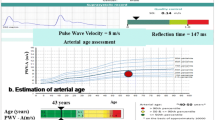Abstract
Hand-held, continuous-wave Doppler probes, coupled with sound spectral analysis, can successfully predict carotid artery stenosis. Changing either the emitting frequency of the probe, the beam/artery angle of the carotid flow velocity (e.g. cardiac output) may alter the recorded frequency shifts. These effects raise questions as to the efficacy of this technique to serially follow carotid atheroma for progressive stenosis. To test the inherent problems with this methodology, a study of reproducibility was conducted. Two Doppler probes (5 MHz and 8 MHz) were compared at the same sitting in 24 patients; 12 were restudied on two subsequent occasions. Peak systolic frequency was 135% higher with the 8 MHz probe; this was lower than the 160% calculated by substitution for emitting frequency in the Doppler formula. The linear correlation coefficient of the two probes was 0.88. In relationship to established laboratory criteria of a >75% area stenosis, no errors were noted with the 5 MHz probe while four errors were noted with the 8 MHz probe. A serial study variation of peak systolic frequency was noted for both probes; these variations did not cross established criteria levels of a severe stenosis when the 5 MHz probe was used, but did with the 8 MHz probe for two carotids. A standard examining probe is recommended. Angle and cardiac output changes do result in peak systolic frequency variation from test to test, but these were not clinically significant with the 5 MHz probe. Thus, significant changes during follow-up testing should provide an index of evolving carotid stenosis.
Similar content being viewed by others
References
SPENCER MP, REID JM. Quantification of carotid stenosis with continous-wave (C-W) Doppler ultrasound.Stroke 1979;10: 326.
ZWEIBEL WJ, ZAGZEBSKI JA, CRUMMY AB, HIRSCHER M. Correlation of peak Doppler frequency with lumen narrowing in carotid stenosis.Stroke 1982;13: 386.
BARNES RW, NIX L, RITTGERS SE. Audible interpretation of carotid Doppler signals. An improved technique to define carotid artery disease.Arch Surg 1981;116: 1185.
HAYES AC, BAKER WH. Noninvasive laboratory evaluation.In: BAKER WH, ed.Diagnosis and Treatment of Carotid Artery Disease, 2nd ed., New York: Futura Publishing Co., 1985: 1–96.
Author information
Authors and Affiliations
About this article
Cite this article
Hayes, A.C., Mahler, D.K., Foldes, M.S. et al. Reproducibility of transcutaneous continuous-wave Doppler testing of the carotid arteries. Annals of Vascular Surgery 1, 469–473 (1987). https://doi.org/10.1007/BF02732672
Issue Date:
DOI: https://doi.org/10.1007/BF02732672




